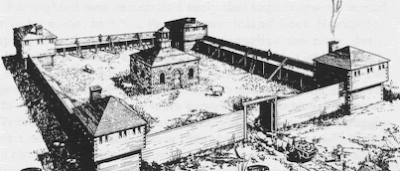In 1987, on the site of Fort Hunter, archaeologists started work before construction began for a parking lot for the Schoharie Crossing State Historic Site. The work resulted in the first recorded material evidence of the 18th century settlement. The full report is fascinating. 199 fragments of bone, teeth and shell reveal the dietary habits of the residents included pork, beef, shell fish, fowl, and possibly venison and mutton. 125 remnants of vessels and utensils were found. The only evidence of alcohol consumption were found in four dark sherds of bottle glass. Of the 114 ceramic sherds with a good percentage being tin-glazed earthenware (delft). Sherds of buff earthenware, white salt glazed stoneware were found but no creamware. Fourteen vessels specifically identified were teawares! Obviously teatime was a ritual at Fort Hunter. Other objects found include a single straight pin, two sections of a shoe buckle, a bone brush, sherds from a medicine vial and two William III and one George II half pennies. An iron Jew's harp was found, which was a common trade item, and 199 white clay fragments of smoking pipes. At least 15 were probably produced by Robert Tippet of Bristol (whose pipes were also found at Fort William Henry and Fort Michilimackinac excavations.) Architectural artifacts included nails. carpenter dividers and window sherds. Deeply buried walls were discovered, but not explored - they may be part of the original fort. All the evidence provides a glimpse into the colonial life at Fort Hunter.
View Larger Map


No comments:
Post a Comment